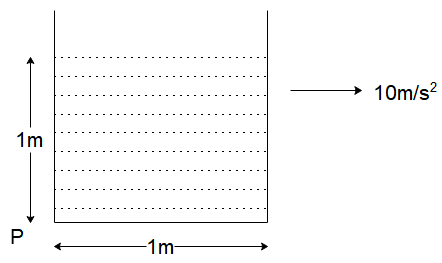
A container is filled with water, accelerating with acceleration


Answer
478.8k+ views
Hint : When the container of the water starts accelerating, the water profile gets tilted away from the acceleration force. The velocity of efflux can be calculated using Bernoulli's theorem.
Formula used: In this solution we will be using the following formula,
Bernoulli’s Equation:
Complete step by step answer:
When the container is filled with water and accelerated, the water profile gets tilted as shown below.

We know that the angle of inclination is calculated as:
Since
Since the length of the container is
Hence the height of water on the left side will be
The velocity of the water can then be calculated using Bernoulli's theorem. Since the water coming out of the container will experience atmospheric pressure too, using Bernoulli’s theorem at the top of the water on the left side and at the bottom of the container of the left side where the water is flowing out, we get
Solving for
Substituting the values of
Which give us
Or
Note:
The formula for finding the velocity of water as it exits the fluid is also known as Torricelli’s theorem. While using the height to find the velocity of water, we must take into account the change in height of water due to its acceleration.
Formula used: In this solution we will be using the following formula,
Bernoulli’s Equation:
Complete step by step answer:
When the container is filled with water and accelerated, the water profile gets tilted as shown below.

We know that the angle of inclination is calculated as:
Since
Since the length of the container is
Hence the height of water on the left side will be
The velocity of the water can then be calculated using Bernoulli's theorem. Since the water coming out of the container will experience atmospheric pressure too, using Bernoulli’s theorem at the top of the water on the left side and at the bottom of the container of the left side where the water is flowing out, we get
Solving for
Substituting the values of
Which give us
Or
Note:
The formula for finding the velocity of water as it exits the fluid is also known as Torricelli’s theorem. While using the height to find the velocity of water, we must take into account the change in height of water due to its acceleration.
Latest Vedantu courses for you
Grade 10 | MAHARASHTRABOARD | SCHOOL | English
Vedantu 10 Maharashtra Pro Lite (2025-26)
School Full course for MAHARASHTRABOARD students
₹33,300 per year
Recently Updated Pages
Master Class 11 Economics: Engaging Questions & Answers for Success

Master Class 11 Business Studies: Engaging Questions & Answers for Success

Master Class 11 Accountancy: Engaging Questions & Answers for Success

Master Class 11 English: Engaging Questions & Answers for Success

Master Class 11 Computer Science: Engaging Questions & Answers for Success

Master Class 11 Maths: Engaging Questions & Answers for Success

Trending doubts
State and prove Bernoullis theorem class 11 physics CBSE

1 ton equals to A 100 kg B 1000 kg C 10 kg D 10000 class 11 physics CBSE

State the laws of reflection of light

One Metric ton is equal to kg A 10000 B 1000 C 100 class 11 physics CBSE

1 Quintal is equal to a 110 kg b 10 kg c 100kg d 1000 class 11 physics CBSE

Difference Between Prokaryotic Cells and Eukaryotic Cells




